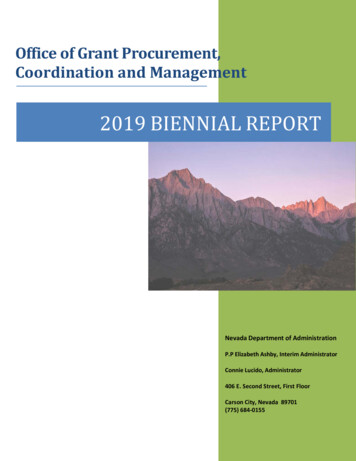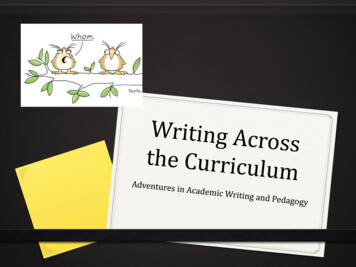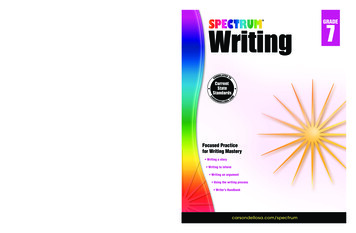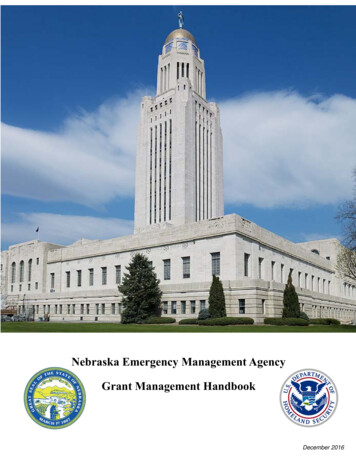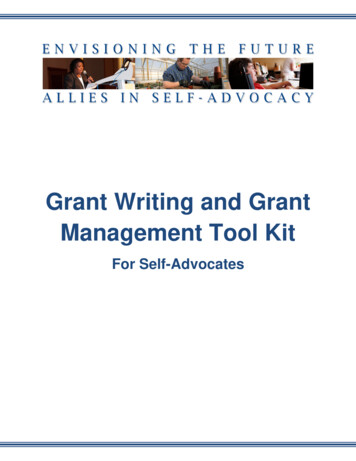
Transcription
Grant Writing and GrantManagement Tool KitFor Self-Advocates
July, 2014This toolkit was published by the Association of University Centers on Disabilities and funded by theAdministration on Intellectual and Developmental Disabilities through technical assistance contract#HHSP23320112917YC. The contents of this document do not necessarily reflect the views or policies of theAdministration on Intellectual and Developmental Disabilities, Administration on Community Living,US Department of Health and Human Services or the US Government.
Table of ContentsPurpose of this Tool Kit . 4Acknowledgements . 5How are grants created by Funders? . 6How do Self-advocates find grants?. 6What are the steps to take to submit a grant application? . 7How are the applications reviewed?. 8What happens if you get the grant? . 9What are grantees expected to do? . 9Lessons learned from the Self -Advocacy Pilot Project Grantees . 10Appendix A: Self-Advocate Tool Kit Checklist . 12Appendix B: Glossary . 17Appendix C: Request for Application (RFA) - EXAMPLE . 21Appendix D: Grant Application - EXAMPLE . 30Appendix E: Scoring Rubric - EXAMPLE . 38Appendix F: Resources. 413
Purpose of this Tool KitIn 2011 the Association of University Centers on Disabilities (AUCD)received funding from the Administration on Intellectual andDevelopmental Disabilities (AIDD) to administer the Self-AdvocacyOrganizational Development Grants, which served as pilot projects forfederal funding of self-advocacy organizations. The goal was to help selfadvocacy organizations become more independent and achieve 501c3status which is also known as becoming a tax-exempt non-profitorganization. AUCD created this toolkit based on feedback from selfadvocates who participated in these Self-Advocacy OrganizationalDevelopment Grants, who expressed interest in writing grant applications.This toolkit is designed to help more self-advocacy organizations apply forgrant in the future.This tool kit is organized to help you answer questions that you might havewhen you are applying for a grant. A checklist is provided for easyreference (see Appendix A). Words that are bolded will be in the glossaryat the end of the tool kit (see Appendix B). Examples (see Appendix B-D)are also provided for grant announcements and applications. Resources foradditional grantwriting information are in Appendix F. Think of this as aroad map. The beginning is always a good place to start.4
AcknowledgementsWe would like to acknowledge the following organizations that have beenso helpful in reviewing this tool kit. We couldn’t have finished this tool kit,without their expertise: Autistic Self Advocacy Network, National Office National Youth Leadership Network AUCD Council on Community Advocacy Self-Advocacy Organizational Development Granteeso Arkansas People First - North Little Rock, ARo Self-Advocates United as 1 - Greenville, PAo Voices of Virginia - Richmond, VAo Autistic Self-Advocacy Network - Portland, ORo New Mexico Allies for Advocacy - Albuquerque, NMo Self-Advocates Becoming Empowered - USAo Colorado Cross-Disability Coalition - Denver, COo Peer Action Disability Support - Iowa City, IA5
How are grants created by Funders? Funders offer grant opportunities to organizations to completea goal. Most grants are created to pay for a specific project thatis a priority for the funding organization. Once a project is defined the funder sends out a Request forApplications (RFA), Notice of Funding Availability (NOFA),Request for Proposals (RFP) or Funding OpportunityAnnouncement (FOA), which are different types of fundingannouncements. This means the funder is announcing thatgrant funding is available and is allowing organizations tosubmit an application for how the funding could be used. (Whenwe use “RFA” throughout the rest of this guide, we mean any ofthese types of funding announcements. We use “RFA” just tosave space.) The RFA will usually outline who is eligible to apply for thegrants, what the expectations are (rules and reporting), howapplications are to be submitted and how the applications willbe reviewed. See Appendix B for an example of what an RFA could look like.How do Self-advocates find grants? Assess the needs and goals of your organization. Network with like-minded organizations and groups to discussshared priorities, goals, and opportunities. Subscribe to appropriate listservs where you can findinformation about grant opportunities. Explore websites (Federal, State, Local, Private, etc.) wherefunding opportunities are announced. Examples of websites, listservs and organizations that arehelpful when looking for funding opportunities include:Grants.gov, Developmental Disabilities (DD) Councils,Chambers of Commerce, and the Foundation Center See Appendix F for examples of websites to search for fundingopportunities.6
What are the steps to take to submit a grant application? Read and explore all relevant RFAs. These are RFAs that areclosely connected with your organization’s goals. Decide which RFA is appropriate for your organization, basedon your priorities, goals, and resources. Some RFAs may have difficult language. Ask for a companiondocument that has more accessible language. If a companiondocument isn’t available, ask for help, if needed. Review the list of Frequently Asked Questions (FAQ), ifprovided. Identify like-minded organizations, groups, partners and allieswho are interested in supporting the project and can helpdevelop and write the application. Be sure to confirmpartnership in a formal letter; this is called a letter of supportand is submitted with the grant. Attend a webinar or conference call (if offered by the funder) tolearn more about the RFA and to ask questions. Write a workplan and timeline to plan out what goals you aregoing to accomplish and to stay organized. These should bedeveloped with your partner to meet the grant goals. Confirm how your application needs to be submitted (by mail,online, etc.).o If applications are submitted online, find out if you mustbe registered on the application website. Get registeredearly so you can submit your application on time.o Understand your application guidelines.o Some RFAs may have templates for each part of theapplication. This is to assist applicants in completing all ofthe necessary information.o If your RFA does not include templates, make sure youknow what each part of the application is asking for, andbe sure to complete all of the necessary information.7
Incomplete applications do not get reviewed, so youhave to complete every part!o Give yourself plenty of time to write your application. It isa lot of work, and it all has to get done before thedeadline. Don’t wait until the last days to get started. Fill out all of the required information using the applicationtemplates on the online application system (if there is one), orby filling out the application forms. Submit the application before the deadline. Late and incompleteapplications will not be considered. Make sure to submiteverything on time. This applies to everyone there will be noexceptions. See Appendix C for an example of a grant application.How are the applications reviewed? All completed applications go through a Panel Review process.A Panel Review is a group of experienced individuals that willreview the applications and score them fairly to makerecommendations for funding. Funders recruit and train peer reviewers who serve aspanelists (also called reviewers).o For example, a panel of 3 reviewers will include peoplewho have experience with the topic of the grant. Thesepeople should not be affiliated with the applicant, toreduce conflict of interest. Reviewers read and score each application on their own.Applications are rated using a score guide and rubric. After the individual reviews, a full review is held with eachpanel. A full review is when all the reviewers meet and go overtheir scores to make final recommendations for funding. Funders award the grants according to which applications havethe highest final scores, and how much money is available. See Appendix D for an example of a scoring guide forreviewers.8
What happens if you get the grant? Once the organization is notified that they received the fundingthey will be given a grant award, and will be considered agrantee. The language in the funding agreement may be difficult tounderstand, so organizations interested in getting fundingshould become as familiar as possible with contract language. If you do not understand the language used in the fundingagreement, be sure to ask questions before you sign it. Youmay want to ask for a companion document that outlines thecontract in more accessible language; however this does notnecessarily mean that one will be provided. You areresponsible to understand what you are signing.What are grantees expected to do? Each grantee is expected to use the funding to complete thework that was proposed in their application, according to thefunding agreement. Reporting, which is communicating to the funder youraccomplishments, has to be done regularly. Reporting timelinesand format are usually provided by the funder. It is always the grantee’s responsibility to make sure invoices,reports, and any other progress report is submitted correctlyand on time. Invoicing to the funder has to be done regularly. If invoices arenot submitted you will not receive your funding. If funded, you must stay in communication with your funder. Ifthere are changes to your workplan, staffing, or budget, yourfunder must be aware and may be able to help you problemsolve. The funder may help to address issues such as key staffchanges, budget modifications, and timeline delays.o If a grantee wants to change the key staff in charge of theproject, they often must get approval from the funder9
o If a grantee wants to make a major budgetmodification, they must inform their funder for approvalbefore making any significant changes. The funder reviews and approves invoices, reviews reports,and possibly provides extra technical assistance or problemsolving to grantees as needed.Lessons learned from the Self -Advocacy Pilot Project GranteesThese are lessons learned by self-advocates who received grant fundingfor their organizations, who wanted to share what they learned with others. Collaboration with state partners was very important to makesure that everyone was on the same page in regards to thegrant. Face to face meetings with partners were the most valuable.Assign funding in the project budget to pay for travel for face toface meetings, if this is allowed. Having a workplan and timeline helped the team stay on target. Communication with staff from the funding agency was veryhelpful. Learning about applying for grants and becoming a 501c3 wasa very rewarding experience. The biggest challenges were working together in a group, andrelying on people who have grant experience, however, it waspositive experience. The team complemented each other’s skills and worked aroundeach other’s weakness. Having confidence in the organization’s partner made theexperience easy. Collaborations were strong because of open communicationwith the team. Conference calls were held once a month. Members of the board who were experienced in writing grantsassisted the team.10
Health issues prevented some individuals from completing theirtasks but with a strong team and good communications, theproject to moved forward. Don’t be afraid to ask questions.11
Appendix ASelf-Advocate Tool Kit Checklist12
Self-Advocate Tool Kit Checklist Look for funders posting a Request forApplications (RFA), Notice of Funding Availability(NOFA), Request for Proposals (RFP) andFunding Opportunity Announcements (FOA) Join networks, listservs, and other groups wheregrant opportunities are announced. (Federal,State, Local, etc.)Ex.– grants.gov, DD councils, Chambers ofCommerce, Foundation Center and others Also consider funding that is not supported bythe government such as Foundations,Corporations, Individuals and FamilyFoundations. Research each opportunity. Consider the grant. Does it match yourorganization’s goals and resources? Do you want to expand existing areas of priorityin your organization? Do you want to add newpriorities in your organization? Know when to say NO - Be honest. Is it a goodfit? Do you have in-house expertise or logicalpartners to apply for that grant? Do you have any partners with similar goals thatyou could work with on the project?13
Consider asking partners for a Letter of Supportfrom the organizations they represent. The lettershould be on letterhead if available. This canhelp strengthen your application (or it may evenbe a requirement!). Check the “Frequently Asked Questions” (FAQ)document for basic questions and answers aboutthe grant application process (if available). Attend webinars and conference calls about theopportunity (if available), or ask for assistance ifyou still have questions BEFORE the deadline.It’s is IMPORTANT to attend LIVE webinars orconference calls so you can ask your questions. Use the templates or forms provided by thefunder, if they are available. The application should be written in such a waythat it’s easy for reviewers to find everything intheir scoring rubric. Be sure that your applicationmatches the rubric or score guide (if available). Make sure your application has all theinformation in the format and order that isrequested from the RFA14
Late and incomplete applications will not beconsidered. Make sure to submit ALL of yourapplication materials ON TIME. It is best tosubmit early in case you experience anytechnical difficulties. If you have any questionsabout submitting applications, call theorganization that is funding the grant beforesubmitting the application. Wait for the funder to contact you about yourorganization’s application. If you are selected, you will receive a fundingagreement. This process may take a long time,but might also happen quickly, depending on theFunder. If there are any changes in the contract contactthe funder. Be sure you fully understand the fundingagreement BEFORE signing it.15
Before you sign the funding agreement, check tomake sure it includes the following: Scope of work Budget Timeline Reporting requirements Request to have a companion document (ifneeded) to help explain the funding agreementlanguage.Reminders: It is important to remember that you mustsubmit reports and invoices on time It is important to also notify the funder ofmajor changes in key staff, budget andtimelines SIGN the funding agreement and get started!16
Appendix BGlossary17
Glossary Affiliated: Having a connection to an organization Administration on Intellectual and Developmental Disabilities(AIDD): AIDD is dedicated to ensuring that individuals withdevelopmental disabilities and their families are able to fullyparticipate in and contribute to all aspects of community life in theUnited States and its territories. Allies: Supporters or advisors to a group Association of University Centers on Disabilities (AUCD)The organization that took the lead on the self-advocacy summits andalso helped manage the organizational mini grants Budget: A budget is the financial plan for a project, and defines howthe funded amount of money will be spent Budget Justification: The budget justification is a written explanationthat describes why the budget was developed, and why it isreasonable Budget Modification: Changes in spending plans that occurs after abudget is approved Companion Document: A document that is connected with thestandard document but has language that is easier to understand Conflict of Interest: A situation where a person or organization hasinterest in different things that might cause decisions to be madeunfairly. For example, someone writing a grant application has aninterest in getting funded, and if that same person was part of areview panel to make a recommendation for who gets funded, he orshe might not be able to make a fair decision. Contract: A written legal agreement, in this case between the funderand the organization that is going to receive the money Contract Language: A way that contract and other fundingagreements are written. Since these are legal documents, specificlanguage is often used and may be difficult to understand18
Funding Opportunity Announcement (FOA): a notice of a grantfunding opportunity; the FOA outlines the project to be funded andgives information about how to apply Frequently Asked Questions (FAQ): Questions that are beingasked often, so the answers to those questions are written andavailable Funders: Organizations or individuals that give you money to workon a project Funding Agreement: this is a legal agreement between a funder andthe organization receiving money. It might be a contract, acooperative agreement, or other legal document that describes theresponsibilities of giving and receiving money Grant: Money given by a funder for a specific project or idea Grantee: Organization that has received and accepted a grant Incomplete: Not complete or unfinished Invoice: Is a document that shows a list of goods or services and theprices that should be paid for them Listserv: Is a program that delivers messages to subscribers on anemail list. Non-Profit: An organization that doesn’t have the purpose of makingmoney Notice of Funding Availability (NOFA): A term some funders usefor the announcement of a funding competition or RFP Panelist: a person who is a part of a group of people who answerquestions, give advice or opinions. In this case, a panelist givesadvice on whether an application should be funded. Partners: One of two or more people, businesses, etc., that worktogether or do business together Peer Reviewers: People who evaluate the work of others who havesimilar experience Pilot projects: a project that is tested out on a small scale, beforebeing tested out in a bigger way Recruit: To look for new members or volunteers to help on a specificproject or a committee19
Request for Applications (RFA): notice of a grant fundingopportunity for a specific purpose; the RFA outlines the project to befunded and gives information about how to apply Request for Proposals (RFP) : Notice of a contract fundingopportunity; the RFP outlines the project to be funded Rubric: Is a guide listing specific reasons for grading or scoringapplications, projects, or tests Self-advocates: People with disabilities standing up for their rights. Technical assistance: Support provided to complete work moreeffectively. Examples include advise, assistance, and training. Template: A sample form or guide Timeline: A schedule of activities and when they will be done Webinar: A presentation that is given online Workplan: A plan on how to accomplish the work required in aproject 501c3 status: Part of the tax code to be a non-profit organization thatdoes not have to pay federal taxes20
Appendix CRequest for Application (RFA) - EXAMPLE21
Request for Application (RFA) - EXAMPLESelf-Advocacy Organizational Development*Used with permission of Association of University Centers on Disabilities (AUCD)BackgroundSelf-advocacy is central to the Developmental Disabilities Act (to learnmore about the DD Act click here). Many programs in the DD Networkhave made self-advocacy a priority and partnered with people withintellectual and developmental disabilities to support self-advocacyorganizations. Local and state self-advocacy organizations are important.They organize and support people with intellectual and developmentaldisabilities so that they can learn from each other, help each other, andwork to make their voices heard. The self-advocacy movement has grownover the past 40 years. Many of these groups seek to operateindependently of the DD Network.In 2011 and 2012, the Administration on Intellectual and DevelopmentalDisabilities (AIDD) supported 9 regional Self-Advocacy Summits to furtherstrengthen the self-advocacy movement in the states and learn aboutnational priorities. Funding of self-advocacy organizations is one prioritythat came out of the Self-Advocacy Summits.AIDD is offering a small number of mini-grants to self-advocacyorganizations. The goal of these grants is to provide self-advocacyorganizations the opportunity to build their organizations and show theirsuccess. There are two types of grants: the first type is for self-advocacyorganizations to grow and become stronger; the second type is for selfadvocacy organizations that are ready to provide peer-to-peer support tohelp other self-advocacy organizations grow and become stronger.The mini-grant application and process will be managed by the Associationof University Centers on Disabilities (AUCD) who facilitated the Self Advocacy Summits and has managed many mini-grants in the past.22
The GrantsThere are 8 mini-grants broken into two groups.Up to 5 awards of 5,000 each for self-advocacy organizations to growand become stronger. Applicants must be self-advocacy organizationsthat have not yet filed as nonprofits at the state and federal level(501(c)3 status).Up to 3 awards of 30,000 each for self-advocacy organizations toprovide technical assistance to other self-advocacy organizations.Applicants must be self-advocacy organizations that have beenrecognized as nonprofits at the state and federal level (501(c)3 status).The grant period will be January 1, 2013 through December 31, 2013.ApplicationApplicants must use AUCD’s online application system atwww.aucd.org/app.Applicants must create a username and password and upload alldocuments to the online application system. Online applications will beavailable by October 10, 2012.All applicants must upload their documents and submit their applications bymidnight, Eastern Time on November 26, 2012. Applicants are encouragedto submit applications early to allow time for any technical difficulties, andfeel free to contact AUCD staff with questions.Find a confusingword? Look for the“Explanation ofTerms” at the endof this document23
Information for Group A ApplicationsCapacity Building for Self-Advocacy OrganizationsMany self-advocacy groups do not have formal registration as a non-profitorganization, and might have very informal structure in place. The grantsoffered here are for self-advocacy organizations that want to move to thenext step of strengthening their organization and become a non-profit. Justlike any nonprofit, self-advocacy groups need to grow their structure andcapacity and work within federal, state and local requirements so that theycan apply for grants, manage grant money, and continue as a strongorganization. This may include the following activities:Hey Group A! This listis called the “scope ofwork” Increasing the number and diversity of membersIncreasing the number and diversity of volunteersWriting a “mission statement” (the purpose of your group)Setting up a process to choose leadershipMaking a plan to carry out activitiesMaking a plan to select advisorsFinding partnersEstablishing an accounting system (keeping track of your money)Writing “by-laws” (the rules for how your organization works and makesdecisions) Filing for local, state and federal (IRS) tax exemptionsOrganizations who get Grant A must work with a partner that is a 501(c)3nonprofit (like an ally or another self-advocacy organization) to accept thefunds and manage the grants. AUCD cannot give money to organizationsthat are not yet nonprofits, which is why this partner is needed here.A Bottom Line:This grant is for self-advocacy organizations that are not yet 501(c)3 nonprofitsto help themselves grow, become stronger, and take steps to be able to applyfor and get other grant funding.24
Application Package:Cover page (see Attachment A) including the name and addressof contact person and partner. This is the person who will be themain contact for this project, and the address where checks will besent.Narrative including the items below (see Attachment B for sample).This should not be longer than 6 pages, double-spaced, in 12point font, with one-inch margins. It includes:o History of your self-advocacy organization, including datestarted, area served, number and diversity of members,number of staff & volunteers, and activities.o Names of people who will work on this project withdescription of duties and their personal and professionalexperience in ID/DDo Explanation of what your organization will do with themoney, according to the “scope of work” listed above forGroup Ao The timeline for activitieso How you plan to continue work when this grant has ended,including getting future funding and continuing self-advocacyactivities.o Roles and responsibilities of a partner (either an ally or otherself-advocacy organization) that can help your organizationmanage the grant (keeping track of what work was done,sending invoices for payment, and keeping track of thebudget). Include details about how the support will beprovided.Short (one or two page) resumes – documents that give a person’sprofessional and educational history – of people who will work onthis projectA “budget justification” – a document that explains why yourbudget costs are reasonable25
Budget:A budget outlining how your organization will use the funds (seeAttachment C for budget worksheet)Letter of Commitment:A letter of commitment from the partner that outlines theirunderstanding of their roles and responsibilities. The letter must besigned by the executive director or CEO of the partnerorganization.26
Information for Group B ApplicationsPeer-to-Peer Assistance to Help Other Self-Advocacy OrganizationsMany self-advocacy organizations have grown enough to be able toprovide peer-to-peer assistance to other self-advocacy groups. Theseorganizations have already become nonprofits (known as 501(c)3 status).The grants offered here are for those self-advocacy organizations that wantto help other self-advocacy organizations become stronger. This mayinclude helping other organizations with the following activities: Writing the “mission statement” (the purpose of theorganization) Setting up a process to choose leadership Writing description of organization Writing “by-laws” (the rules for how the organization works andmakes decisions) Completing paperwork to become a formal non-profit 501(c)3organization at state and federal level Creating and maintaining financial records (writing budgets andkeeping track of the money) Writing grants and finding funding for self-advocacy Managing public and private grants (applying for grants, writingreports, submitting invoices, and doing the work) Building partnerships with other organizations Using the internet and technology for meetings, trainings,discussions, resource sharing, and community building Increasing the number of members and volunteers thatrepresent the diversity of the state Learning what people with disabilities in your community need Creating a plan for the organization for the future Advocating for themselves and others27
Application Package:Cover page (see Attachment A) including the name and addressof contact person. This is the person who will be the main contactfor this project, and the address where checks will be sent.Narrative including the items below (see Attachment B for sampletemplate). This should not be longer than 6 pages, double-spaced,in 12-point font, with one-inch margins. It should include:o History of the organization, including how the organizationgrew and gained 501(c)3 status, the area served, number ofmembers, number of staff & volunteers, and activities.o Names of people who will work on this project withdescription of duties and their personal and professionalexperience in ID/DDo Explanation of what your organization will do with the funds,according to the scope of work outlined above for Group B,including The organizations to whom you plan to providetechnical assistance The areas of technical assistance that yourorganization plans to offero The timeline for activitieso A plan to continue work when this grant has ended, includinggetting future funding and continuing self-advocacy activities.o Experience assisting other self-advocacy organizations, ifanyShort (one or two page) resumes – documents that give a person’sprofessional and educational history – of people who will work onthis projectA “budget justification” – a document that explains why yourbudget costs are reasonable28
Budget:A detailed budget outlining how your organization will use thefunds (see Attachment C for budget worksheet)Letters of Commitment and Documentation of Nonprofit Status:Documentation of federal 501(c)3 statusLetters from the organizations that you plan to provide technicalassistance to29
Appendix DGrant Application - EXAMPLE30
Grant Application - EXAMPLE*Used with permission of Self Advocates Becoming Empowered (SABE)This application was submitted in response to the RFA in Appendix A[Some names have been removed, for purposes of privacy.]H
Development Grants, who expressed interest in writing grant applications. This toolkit is designed to help more self-advocacy organizations apply for grant in the future. This tool kit is organized to help you answer questions that you might have when you are applying for a grant. A checklist is provided for easy



